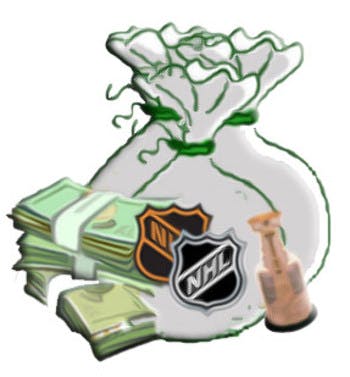On Value: Cap Hits and Perception
By Arik
11 years ago
In the history of hockey, the salary cap is relativey a new idea. In some ways it seems like it’s been around forever, but the implementation was only a few years ago and how we tend look at it shows that.
As fans and writers who will likely never see anywhere near the amount of cash the players do, we frequently get caught up in flashy, gaudy numbers. We see a contract like Luongo’s and think "TEN MILLION?! OUTRAGEOUS!", while ignoring the fact that his cap hit is a tiny $5.3M.
Of course, more and more fans are perceiving the difference between salary and cap hit, but even so, plenty of Flames fans see Jay Bouwmeester’s cap hit of $6.68M and balk, not realizing that $6.68M isn’t as bad as it seems.
So how should we perceive a player’s salary and salary cap hit?
The thing both of these are missing is context: the salary cap itself and how it compares to average NHL cap hit.
The salary cap context is simple: it’s a matter of determining a given player’s cap percentage. If you take a player signed in 2005-06 at a $3.9M cap hit, for example, and divide it by the salary cap, multiply by one hundred, you end up with his hit percentage. For 2005-06, that CH% is 10%.
Now, 10% is a fine number if you’re a good first liner or a legitimate top pairing defenseman, but other than that it’s a bit much. That said, we often still perceive the $3.9M the same way, despite the fact that the CH% for the same amount is now much lower. In 2011-12, the salary cap was at $64.3M, making a $3.9M cap hit percentage just of 6%.
To add context, a quick statistical survey of several teams determined that the average cap hit in the NHL is approximately $2.453M (the Flames, as a point of reference, are at $2.458M). This covers a wide range of players, but the bulk of the guys in the $2M-$3M range are considered average to slightly above average (at best). Andrew Cogliano, with a salary cap hit of about $2.39M, represents the player closest to that number, but Hal Gill, Nikolai Kulemin, Anton Babchuk, TJ Oshie, and Teddy Purcell are all in that range for various reasons: some are RFA deals, some are for players with "issues", and some are deals for merely average players.
Now, the reason that particular number matters is that $2.39M = 3.8% of the salary cap.
When you compare that average player number to Mystery Player X’s 6.07% and consider that UFAs command a higher price tag than RFA and ELC contracts, it becomes a even more palatable than most fans initial reactions.
The idea here is that instead of just looking at a big number and failing to place it in context, folks need to consider the dollars relative to the total cap and the league average contract. There are certainly times to take raw salary into account: poorer teams and their fans should consistently do this when looking at contracts, as those owners can usually ill-afford to at pay high amounts. For teams with considerable amounts of money (i.e. the Rangers, Maple Leafs, Canadiens), as well as teams with decent money (the Flames, Penguins, Lighting, and most of the league), the cap hit percentage should be of far greater concern.
The Cervenka Deal
This method makes the recent Cervenka contract seem even more reasonable – his cap hit (including all bonuses) of 3.77M is just 5.9% of the current ceiling and may well fall lower should the cap get any kind of bump this summer. That’s a pretty small amount of the budget to pay for a guy if he can effectively play in your club’s top-6 rotation.
Five years ago, Cervenka’s deal would have been a much bigger chunk of the cap and therefore a much bigger gamble. Today, however, the risk is subdued by the cap’s inflation.
Recent articles from Arik





